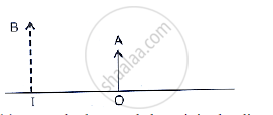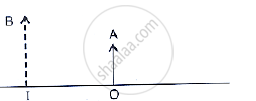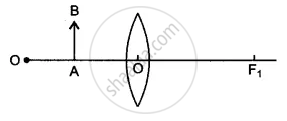Advertisements
Advertisements
प्रश्न
Observe the following figure and complete the table:

| Points | Answer |
| (i) Position of the object | |
| (ii) Position of the image | |
| (iii) Size of the image | |
| (iv) Nature of the image |
उत्तर
| Points | Answer |
| (i) Position of the object | between F1 and optical center |
| (ii) Position of the image | same side to the object (between 2F1 and F1) |
| (iii) Size of the image | Magnified |
| (iv) Nature of the image | Virtual and erect |
APPEARS IN
संबंधित प्रश्न
A student places a candle flame at a distance of about 60 cm from a convex lens of focal length 10 cm and focuses the image of the flame on a screen. After that he gradually moves the flame towards the lens and each time focuses the image on the screen.
(a) In which direction-toward or away from the lens, does he move the screen to focus the image?
(b) How does the size of the image change?
(c) How does the intensity of the image change as the flame moves towards the lens?
(d) Approximately for what distance between the flame and the lens, the image formed on the screen is inverted and of the same size?
When a ray of light enters from one medium to another having different optical densities it bends. Why does this phenomenon occur?
Complete the following table:
| Instrument | Number of Convex Lenses |
Use |
| Simple Microscope | .............. | .............. |
| Compound Microscope | .............. | .............. |
| Telescope | .............. | .............. |
A beam of light travelling in a rectangular glass slab emerges into air. Draw a ray-diagram indicating the change in its path.
A ray of light travelling in air is incident on a parallel-sided glass slab (or rectangular glass slab). Draw a ray-diagram indicating the change in its path in glass.
Draw a labelled ray diagram to show how a ray of light is refracted when it passes:
from an optically denser medium into air.
Draw a labelled ray diagram to show how a ray of light passes through a parallel sided glass block:
if it hits the glass block at 90° (that is, perpendicular to the glass block)
f the image formed by a convex lens is of the same size as that of the object, what is the position of the image with respect to the lens?
An object is placed at a distance equal to 2f in front of a convex lens. Draw a labelled ray diagram to show the formation of image. State two characteristics of the image formed.
State whether convex lens has a real focus or a virtual focus.
An object is placed f and 2f of a convex lens. Which of the following statements correctly describes its image?
(a) real, larger than the object
(b) erect, smaller than the object
(c) inverted, same size as object
(d) virtual, larger than the object
A convex lens of focal length 8 cm forms a real image of the same size as the object. The distance between object and its image will be:
(a) 8 cm
(b) 16 cm
(c) 24 cm
(d) 32 cm
An object 3 cm high is placed 24 cm away from a convex lens of focal length 8 cm. Find by calculations, the position, height and nature of the image.
Which of the above two cases illustrates the working of a magnifying glass?
How would a pencil look like if you saw it through How would a pencil look like if you saw it through
An object is placed 20 cm from (a) a converging lens, and (b) a diverging lens, of focal length 15 cm. Calculate the image position and magnification in each case.
The focal lengths of four convex lenses P, Q, R and S are 20 cm, 15 cm, 5 cm and 10 cm, respectively. The lens having greatest power is :
(a) P
(b) Q
(c) R
(d) S
What kind of lens is used to correct
long-sightedness?
A parallel oblique beam of light falls on a convex lens. Draw a diagram to show the refraction of light through the lens.
The given below figure shows an object OA and its image IB formed by a lens.

The given below figure shows an object OA and its image IB formed by a lens
. 
draw suitable rays to locate the lens and its focus.
A lens forms an upright and magnified image of an object State whether the image is real or virtual
In the following cases, where must an object be placed in front of a convex lens so that the image formed is of the same size as the object?
While determining the focal length of a convex lens, you try to focus the image of a distant object formed by the lens on the screen. The image formed on the screen, as compared to the object, should be
(A) erect and highly diminished
(B) erect and enlarged
(C) inverted and enlarged
(D) inverted and highly diminished
List four properties of the image formed by a convex mirror.
Distinguish between:
Concave lens and Convex lens

i. Which type of microscope has the arrangement of lenses shown in the adjoining figure?
ii. Label the figure correctly.
iii. Write the working of this microscope.
iv. Where does this microscope used?
v. Suggest a way to increase the efficiency of this microscope.
Where should an object be placed in front of a convex lens to get a real image of the size of the object?
Where must a point source of light be placed in front of a convex lens so as to obtain a parallel beam of light?
State the position of object, position of image, nature of image when: Convex lens is used in cine projector.
A concave mirror and convex lens are held in water. What changes, if any, do you expect in their focal length?
A candle is placed between f and 2f a convex lens. Draw a ray diagram showing the position of the image.
Diagram shows an object AB placed on the principal axis B of a convex lens placed in air. F1 and F2 are the two foci of the lens.

(i) Copy the diagram:
Draw a ray of light starting from B and passing through O. Show the same ray after refraction by the lens. Draw another ray from B which passes through F2 after refraction by the lens. Locate the final image
(ii) Is the image real or virtual?
Which of the following statements is true?
A convex lens of focal length 20 cm can produce a magnified virtual as well as real image. Is this a correct statement? If yes, where shall the object be placed in each case for obtaining these images?
Distinguish between Concave lens and Convex lens.
Distinguish between Concave lens and Convex Lens.
Distinguish between:
Concave lens and Convex lens
